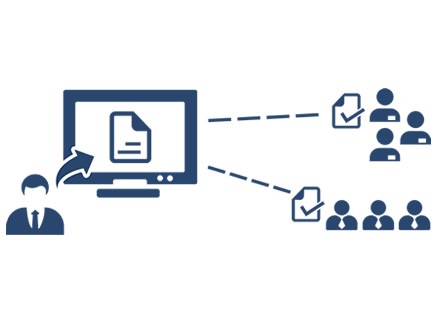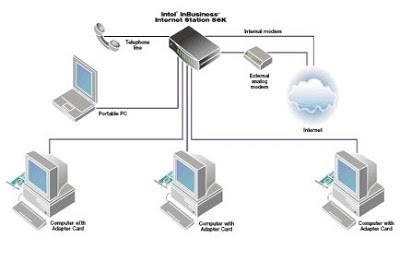
Index:
UPDATED ✅ Do you need to know what an Extranet network is and how it works and its uses? ⭐ ENTER HERE ⭐ and discover everything about this network ✅ EASY and FAST ✅
The extranet is a private network that controls access to a group of predetermined users. Its name comes from the Latin vocabulary “extra” (outside) “net” (red), that is, a connection to the network from outside.
In other words, This allows external people or people outside the company to connect to an internal network. to view or share information. As long as you have the necessary access and credentials to enter.
In this tutorial we are going to explain step by step what this system is and what it is for? The differences it has with the Internet, as well as the risks and advantages that this type of connection can bring.
What is the Extranet and what is this communication technology for?

It is a private network which uses Internet protocols, communication protocols and a public communication infrastructure, in this way to be able to safely share all the information or a part of it.
In other words, it can be part of the Intranet, which is part of the organization that extends to different users outside of it.
Commonly it has a semi-private access. To enter this, it is not mandatory for the user to be a company worker, but they must have some connection with the entity.
It is for this reason that this type of network needs to have a reliable level of security, thus preventing anyone from accessing it.
This type of network allows people outside the company, They can be: customers or suppliers, have access to a part of the organization’s Intranet.
In technical terms, we are talking about a firewall that also allows access to external users. In short, it serves to connect external users to internal company information. It should be noted that this information is very superficial, and it will only be what the entity is interested in showing.
For example, a customer can see the quantity in stock of a product. The employees of the company view the prices, the quantity in the warehouse or invoicing, etc.
Among other applications it has:
- Online banking: it is the best known example of an extranet; Through it, the bank provides the possibility for its clients to consult their accounts and operate on them.
- Groupware: allows various companies to participate in the creation of new applications with a common goal.
- Budgets and orders.
- Catalogs and offers.
- Technical assistance.
- Software download.
What are the main characteristics of such a network?
The characteristics of this type of connection are very useful, and for this reason, more and more sectors decide to use it every day.
They are between them:
- Large amounts of data can be exchanged and sent. Product catalogs can be shared with wholesalers, distributors, companies.
- The same or other services may be provided and accessed, which are provided by the company or a group of companies. For example, with clients, you can share news and novelties of this and its associations.
- Access to external users of the company.
The Extranet: How do these types of networks work?
Its operation is a bit complex to explain, but it is very easy to understand. As previously indicated, it is an external network that allows people outside a sector to access important information, carry out transactions, etc.
For its correct march an identification is needed (Username), and a key (can be created by the user or delivered by the company). In addition, access levels for customers and sellers must be established, in this way we will increase security.
Explaining it another way, the Extranet shares a similar configuration with the Internet. For this reason, the communication that takes place between the two networks occurs thanks to a set of 500 network protocols that manage to determine the form, rules and format in which communication can take place.
In this sense, internet protocol ip It is very important, and together with transmission control or TCP, they form the basis of data exchange.
Internet vs Extranet. How are they different and which of the two is better?
There are some very notable differences between the Internet and Extranet.
Among which we indicate the following:
- The Internet is a public access network. Which means that any user can enter and get the information that is available in it.
- In the case of the extranet, access is only for those previously registered (private), so they are given a username and a password so that they can enter and observe partial and controlled information.
Which of the two is better? This question depends on the need of the user or the company. In case it is a commercial company or with a remote work modality, the best thing you can apply to connect it with workers and clients is to use the extranet.
As will allow your workers to send and receive valuable information, without outsiders being able to observe or manipulate it. In the case of your customers, they will be able to observe data about products and services without the need for direct or semi-direct contact with the company.
But, if you are just an ordinary user who wants to send and receive some data that is not of extreme importance, it is best to use the Internet and the email service.
What is needed to create an Extranet network and how to do it?
There are two ways to create a network and be able to integrate it into corporate communication, for both cases they are portals:
- corporate portals: it is the type of portals that brings all applications together in a single user interface. This is a great advantage when many tools from different extranets are integrated. Because the user is prevented from having or having to switch between different management modes and authenticate several times.
- Portals for processes: they are portals oriented to commercial processes, they are designed to carry out tasks on orders, cost calculations, etc.
Another alternative method to create it is using a content management system or program. This range of functions covered by the software may vary depending on the CMS that is used.
To create it vas to require certain elements such as: security and privacy for the network. An administration for the Firewall server, the issuance and use of digital certificates; for user authentication, a message encryption system and the use of virtual private networks (VPN); that will make a direct connection through the public network.
But it is best to always turn to a specialist in the area, in order to correctly create this type of connection.
Why should you use this network? Advantages and disadvantages
The reason why this type of network should be used is basically because of the ease and freedom it offers the company to manage different areas of it. Whether they are aimed at common users or their workers, without them being confused or unintentionally joined.
Advantages of the Extranet
There are several advantages that make it convenient to implement this type of network in your company or institution.
Among them we name the following:
- Greater speed in the exchange of data and relevant and irrelevant information.
- Productivity increase.
- Savings in time and cost.
- Data maintenance is easy.
- Optimized communication with partners and customers.
- Cooperative work is easier to do.
- Improve management.
- Internet address under your own domain.
- It allows secure transactions between the entity’s internal systems.
- Company workers can quickly and easily obtain information about customers, suppliers and partners.
It is also important to mention that, previously, the problem of companies was based on geography, but thanks to the implementation of this network, today it is possible to see updated information at the moment. This makes it easier for employees to optimally perform their task together with other people remotely.
Disadvantages of the Extranet
Like many technologies and new tools, there will always be bugs or drawbacks, but they are usually a very small factor to consider, compared to all the advantages that this technology brings.
Among the disadvantages are:
- Higher costs of acquisition and maintenance of servers and other services.
- Danger to possible infiltrations of unwanted people. (However, this can be avoided with strong security measures).
- Reduced personal contact with customers and business partners.
Internet